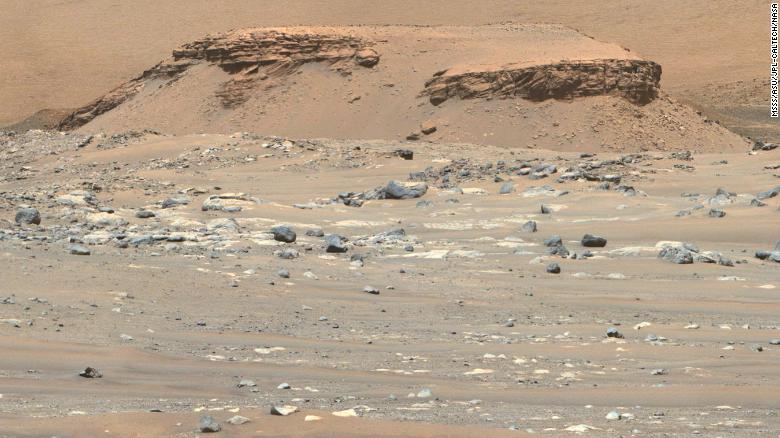
Lava once flowed at the site of an ancient lake on Mars.
The Perseverance rover landed on the planet just 10 months ago, but it has already made that surprising discovery.
The rover’s latest finding suggests that the bedrock it has been driving over since landing was once formed by volcanic lava flows – something that was “completely unexpected,” according to mission scientists. Previously, they thought the layered rocks Perseverance took photos of were sedimentary.
The rocks that Perseverance has sampled so far also revealed that they interacted with water multiple times, and some of them include organic molecules.
These discoveries could help scientists create an accurate timeline for the events that have taken place in Jezero Crater, the site of an ancient lake, and has wider implications for understanding Mars.
The finding was announced Wednesday during the American Geophysical Union Fall Meeting in New Orleans.
For years, scientists have questioned if the rock in this crater was sedimentary rock, comprised of layers of material deposited by an ancient river, or igneous rock, which forms when lava flows cool.
“I was beginning to despair we would never find the answer,” said Ken Farley, Perseverance project scientist at the California Institute of Technology in Pasadena, California, in a statement.
Everything changed when Perseverance began using a drill on the end of its robotic arm to scrape away at the surfaces of rocks.
“The crystals within the rock provided the smoking gun,” Farley said.
Perseverance is armed with a suite of sophisticated instruments that can image and analyze these scraped rocks, revealing their composition and mineral content. Ones of these instruments is PIXL, or the Planetary Instrument for X-ray Lithochemistry.
In November, Perseverance used its instruments to study a rock, nicknamed “Brac” by the team. The analysis revealed large olivine crystals surrounded by pyroxene crystals, both of which pointed to the fact that the rock came from volcanic lava flows.
“A good geology student will tell you that such a texture indicates the rock formed when crystals grew and settled in a slowly cooling magma – for example a thick lava flow, lava lake, or magma chamber,” Farley said.
“The rock was then altered by water several times, making it a treasure trove that will allow future scientists to date events in Jezero, better understand the period in which water was more common on its surface, and reveal the early history of the planet. Mars Sample Return is going to have great stuff to choose from.”
The video below shows a pan across the Jezero Crater’s delta created from NASA Perseverance rover imagery captured on Mars.
Now, the team wants to know if the rocks containing olivine were formed by a cooling lake of lava, or if they originated from a subsurface chamber of lava that was later exposed due to erosion.
“This was completely unexpected, and we are struggling to understand what it means,” Farley said. “But I will speculate that this is not likely the original crater floor. From the diameter of this crater, we expect the original crater floor is significantly deeper than where we are right now.”
It’s possible that lava flowed down into the crater, he said, but the original crater floor is below the rock they are driving over now.
Bringing back samples
So far, Perseverance has collected four rock samples with plans to collect up to 37 more. These samples will be returned to Earth by future missions, which will enable them to be studied in great detail and a variety of ways. Samples from Jezero Crater and its river delta could reveal if life ever existed on Mars.
Once back on Earth, volcanic rocks can be dated with very high accuracy, so these latest samples could help the team establish more accurate dates for features and events on Mars.
These rocks interacted with water over time to create new minerals. The minerals within the samples can reveal what the climate and environment was like and even the composition of the water billions of years ago on the red planet.
“That will tell us whether or not the water that existed there was potentially habitable in the past,” said Kelsey Moore, geobiologist and postdoctoral scholar research associate in planetary science at the California Institute of Technology.
The rover also detected organic molecules in the rock it sampled, using its SHERLOC instrument, or Scanning Habitable Environments with Raman & Luminescence for Organics & Chemicals.
The presence of organic molecules doesn’t necessarily equal signs of past life, or biosignatures. Organics can be created biologically or abiotically – a physical process that does not include living organisms.
The Curiosity rover, which landed on Mars in 2012, has also discovered organics within its landing site of Gale Crater. Now that Perseverance has detected them, too, “this helps us understand the environment in which the organics formed,” said Luther Beegle, SHERLOC principal investigator at NASA’s Jet Propulsion Laboratory in Pasadena, in a statement.
While more investigation is needed to determine how these organic molecules were created, their presence gives the science team hope. That’s because it means that signs of past or present life could be preserved on Mars as well, if life ever existed there.
“When these samples are returned to Earth, they will be a source of scientific inquiry and discovery for many years,” Beegle said.
And Perseverance has also been using its onboard ground-penetrating radar instrument, the first ever to be tested out on Mars. The Radar Imager for Mars’ Subsurface Experiment, or RMFAX, was used to “to peek into the subsurface and determine the structure of a rock under our wheels,” said Briony Horgan, associate professor of planetary science at Purdue University and a scientist on the rover mission.
The experiment was used as the rover drove across a ridgeline. The radar data revealed multiple rock formation with a downward tilt, which continue below the surface from the ridgeline itself. Instruments like RIMFAX can help scientists create a better geologic map of Mars to understand its history.
Liquid water found in Valles Marineris canyon on Mars
Scientists have found another pocket of water in the Valles Marineris canyon on Mars, according to ANU astrophysicist and cosmologist Dr Brad Tucker.
“Valles Marineris is this giant canyon on Mars, so it’s about 4,000 kilometres wide or long, so it’s wider than Australia, 200 across, and it could be seven kilometres deep, it could be the Grand Canyon on steroids,” he told Sky News Australia.
Dr Tucker said it is believed to have been formed by erosions like canyons on Earth, and underneath a probe has proved there is liquid water.
“Everywhere we keep looking on Mars, we find ice, we find water underneath the surface,” he said.
“It becomes exciting because we really do think this place was hospitable, did have life, and then it strongly has the chance that’s there now and discoveries like this give us more places to look.”
Investigating an ancient river
Perseverance had a banner year in 2021 and it will move on to even more intriguing territory next year: the ancient river delta.
This fan-shaped structure has intrigued scientists for years, and Farley said the rover will arrive at the delta in about six or eight months.
The rocks in the delta are most likely sedimentary, trapping and preserving precious layers of silt from the river that once flowed into the crater’s lake. And the samples could reveal if organic molecules associated with signs of life, or even microfossils, could be hiding within the remains of the delta. [CNN, Space]
MARTIANS EXIST BUT IS IT GOOD TO DISTURB THEM?
Now subscribe to this blog to get more amazing news curated just for you right in your inbox on a daily basis (here an example of our new newsletter).
You can also follow us on Facebook and/ or Twitter. And, by the way you can also make a donation through Paypal. Thank you!
You should really subscribe to QFiles. You will get very interesting information about strange events around the world.














On the other side of that mountain is a casino and a Martian version of the Mustang Ranch.
What is it that they must black out at bottom of 2nd screen shot.
Well, based upon the corruption of science, and all our government taxpayer funded agencies—I’m underwhelmed.
Show me the close up pictures of the pyramids and rock face monument. Otherwise, I’d rather watch grass grow.